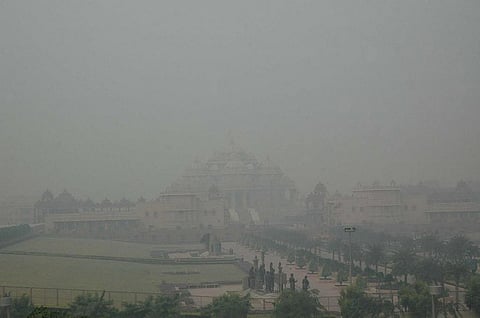

The first phase of this year’s winter in the Delhi-national capital region (NCR) has shown early signs of improvement in air quality, according to Delhi-based non-profit the Centre for Science and Environment. A relatively cleaner Diwali this year gave the pollution-laden national capital a much-needed breather.
The average levels of fine particulate matter (PM) went down to 142 microgrammes per cubic metre (µg/m3) for October and November. This is the lowest level recorded since the city installed these stations in 2018, the non-profit noted.
Delhi recorded five good air days, thanks to the heavy rainfall in October this year. This number is the highest in the last five years. A good air day is when the PM2.5 levels are less than 30 µg/m3. Last year, there was one good air day, while no good air days were recorded in the winters of 2018, 2019 and 2020.
Anumita Roychowdhury, executive director, research and advocacy, CSE said:
Diwali in a warmer October, lower incidents of crop fires that otherwise tip the local pollution over dangerous levels, pre-emptive action based on pollution forecasting and favourable meteorological conditions, including extended rainfall in October, have all contributed towards bending of the early winter pollution curve.
PM 2.5 concentration on Diwali night (8 pm-8 am) this year stood at 289 μg/m3, a good 61 per cent lower than last year’s Diwali night when it was 747 μg/m3. The festival also took place earlier in the year than usual, which might have played a role.
The fine particulate levels in the national capital this October-November were 15 per cent and 18 per cent lower compared to October-November of 2018 from a city-wide average of 37 Continuous Ambient Air Quality Monitoring Stations (CAAQM) and 10 older stations, respectively.
Levels have been 38 per cent lower compared to October-November of 2016, which was the worst autumn in the last eight years, CSE further said. All major cities of NCR more polluted than smaller towns have recorded the least levels in the previous three years.
Delhi was the most polluted major city in NCR, with an October-November average of 142 µg/m3. Gurugram, with 134 µg/m3 and Ghaziabad, with 131 µg/m3, followed the national capital in the list, according to the analysis.
The average PM2.5 this year for Ghaziabad, was 36 per cent lower than in the same period in 2020. Similarly, Greater Noida and Faridabad registered improvements of 28 per cent and 22 per cent, respectively.
This is higher than Delhi’s city-wide improvement of 19 per cent in the same time frame. Gurugram showed the least improvement, with a mere 15 per cent change, the analysis found. Noida’s October-November average PM2.5 this year appears to be 40 per cent lower than in the same period in 2020.
The analysis also noted that one of Noida’s CAAQM stations was reporting uncharacteristically low values this season, which needs to be examined.
The total number of farm stubble fires reported this year from Punjab, Haryana and Delhi was 37 per cent and 42 per cent lower than the October-November of 2021.
There were 54,391 stubble fires, according to United States’s National Aeronautics and Space Administration VIIRS satellite and 11,824, according to NASA’s MODIS satellite.
No severe smog episode has been recorded so far during this season. A smog event lasting at least three consecutive days with an air quality index at a severe level is called a severe smog episode. There is usually one such episode in October-November lasting six-10 days.
Deep-rooted interventions are needed throughout the year to sustain the change, said Roychowdhury. “The region may have avoided the severe pollution levels. But poor and very poor levels as per the air quality index category are not acceptable from the public health standpoint,” she added.